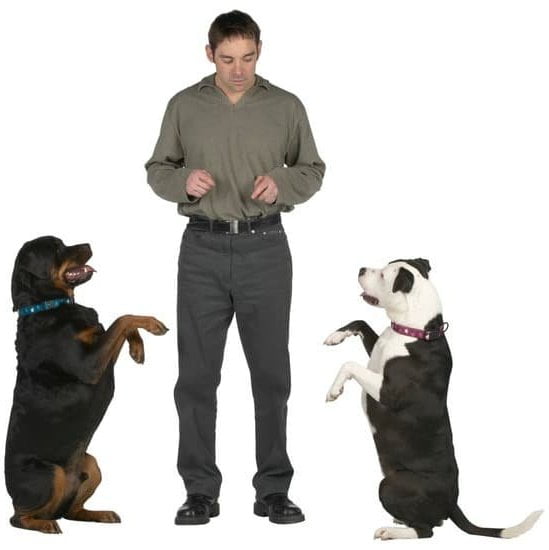Introduction
Training deaf dogs is an incredibly rewarding but difficult task. Many traditional methods of training dogs rely on verbal and audible cues that are not available to the owner and trainer of a deaf dog. Instead, these dogs require special or alternative training techniques, such as reward-based positive reinforcement or the use of vibrating collars. Vibrating collars provide a consistent signal to the dog which can be used to both alert them and help train them with commands.
Vibrating collars work by using a remote control to activate one or more receivers on the collar when a specific button is pressed, emitting a signal through the receivers that the dog can feel and recognize as a cue. This signal may be in response to a behavior, such as barking, or it could be given in order to get their attention and guide them through certain tasks during training sessions. The strength of the vibration may also be adjusted depending on how responsive the dog is.
When choosing a vibrating collar for use with your deaf dog it is important to consider their individual needs and preferences as every dog is different. It’s best practice to begin your training sessions with short and simple commands so you can gauge your success with stronger signals if needed over time. You should also ensure that you have each command clearly defined for yourself so you know exactly when you should expect responses from your pup – consistency is key! With patience and dedication, vibrating collars can be an effective tool for training deaf dogs of all ages successfully.
Benefits & Modifications of Training Deaf Dogs With Vibrating Collars
The use of vibrating collars can be beneficial to deaf dogs when used correctly in order to enhance their quality of life. Training with vibrating collars can help the pup understand commands on a deeper level than just visual or tactile cues alone. Because deaf dogs are unable to hear sound, they rely heavily on body language, facial expressions and tactile communication as their primary way of understanding the world around them.
In addition to being an effective training tool for deaf dogs, vibrating collars also offer other benefits such as reducing nuisance barking and helping owners locate lost dogs more quickly as these collars provide a more focused assistance compared to using standard acoustic sound-based methods. It should be noted that some breeds may not respond well to this type of training, so it is important that owners thoroughly research the best option for their pup before using this method.
Though vibrating collars can be extremely helpful in managing behavior issues in deaf dogs, there are certain modifications that must be made so that they do not become uncomfortable or irritating to the dog. Adjusting the collar regularly depending on the size and type of coat will usually suffice, but if necessary it is possible to purchase additional cushioning material to make sure the collar lies comfortably against the dog’s neck. Additionally, ensuring sufficient training time and introducing reward-focused activities in order to reinforce good behavior can further increase a dog’s responsiveness with this type of training.
Training Techniques & Commands Using Vibrations
Training deaf dogs can be challenging. However, with the use of a vibrating dog collar, the task becomes much easier. Vibration from the collar is sensed by the dog and acts as a signal to elicit behavior modification. Unlike audible commands, vibrations are felt rather than heard and are especially effective in teaching deaf dogs different commands or behaviors.
When training your deaf dog with a vibrating collar, it is important to first familiarize them with the sensation by placing the collar around their neck with no vibration abruptly occurring. Once your dog is comfortable wearing the collars you can then begin training them using vibrations to signify commands and behavior reinforcements. To introduce a new command or behavior start off slow by giving one short vibration every time your dog performs an action you want encouraged before gradually increasing frequency of vibrations that correlate to more intense levels of encouragement depending on how quickly your dog learns. For example, one short vibration would signify ‘good’ when teaching simple commands like sit whereas multiple long vibrations may be best when training more complicated tasks like heeling next to you during walks. With any type of collar based reinforcement remember that timing and consistency is key – always give vibrations at the exact same time your pup meets expectations so that they learn faster and positively react to correct behavior real-time!
Different Types of Vibrating Collars & Accessories for Deaf Dogs
Vibrating collars are a popular and successful way to help train deaf dogs. By using vibrations instead of sound, these specialized devices can help dogs understand commands when vocal cues aren’t possible. There are many different types of vibration collar available for deaf dogs, each with its own unique features and benefits. In addition to standard vibrating collars, there are also accessories that can be used to enhance the training process such as vibration discs, clapping plates and remote controls. Vibration discs are placed on the floor and physically activate the collar via vibration instead of sound waves. Clapping plates work like applause meters – if your dog executes a command correctly they receive a positive reinforcement in the form of a loud clap from you. Finally, remote controls allow you to vary the intensity or duration of vibrations from afar which can be particularly useful during long-distance training sessions. With this variety of specialized products available, there is sure to be something to suit every deaf dog’s individual needs.
Alternatives to Vibrating Collars for Training Deaf Dogs
Vibrating collars are a popular way to train deaf dogs, as the vibration is tactile and can be felt more easily than verbal commands. However, there are many alternative methods that do not require any type of collar. These include hand signals, scent-markers, and positive reinforcement techniques such as clicker training. Using hand signals just means standing in front of the dog and displaying a specific gesture – much like you would use sign language to communicate with someone who is deaf – such as pointing in a particular direction or touching your nose when you want the dog to pay attention. You can also use scent-markers, which involve applying an odor (for example essential oils) onto objects that you point or tap for the dog to look at or go towards when giving a command. Finally, positive reinforcement techniques such as clicker training reward desired behaviors whenever they occur and using rewards can often be more effective in getting desired behaviors from your canine companion than punishment or negative reinforcement.
Tips for Keeping Deaf Dogs Engaged & Recognizing Their Responses
One of the best ways to train deaf dogs with vibrating collars is to rely heavily on visual cues as opposed to verbal cues. When introducing a new command or technique, it is important to break down it down into simple steps and focus on each step until your dog clearly understands what you are asking him. Start with short commands, such as sit or stay, then gradually increase the difficulty as you feel your dog is ready.
It’s also essential to use proper hand gestures since these will be easier for your dog to recognize than verbal instructions. For example, when teaching a “sit” command, hold your hand up in front of them like an “L” shape and lower it toward the ground. The moment your dog follows the gesture, reinforce their good behaviour by providing a treat or praising them verbally. Additionally, don’t forget that deaf dogs may need longer training sessions in order to keep paying attention and taking in new information!
In addition, recognizing deaf dogs’ responses can take some time and patience but can be done with practice. Use a combination of positive reinforcement techniques such as offering treats and physical affection when they correctly follow a command or signal. Body language can often be used to gauge whether or not a deaf dog has understood something correctly – for instance if they follow your gaze when signaling them – so don’t be afraid to experiment!
Safety Guidelines for Training Deaf Dogs With Vibrating Collars
When using a vibrating collar for training deaf dogs, it is important to follow the manufacturer’s guidelines for use carefully. Additionally, owners should ensure the following safety precautions are followed:
• Adjust the collar’s intensity setting prior to use. Intensity should begin at a low level and increase gradually only if necessary. Be sure that your dog can tolerate the sensation of vibration before increasing intensity.
• Use caution when introducing a vibrating collar in environments that may be distracting to your dog such as parks or public places.
• Train in short sessions with breaks in between and avoid overstimulating your dog by continually using the vibrating collar while working towards achieving desired behaviors or commands.
• Check the collar regularly and replace it immediately if any components become worn or damaged. Never attach tags or tags-on-collar to an electronic device like a remote trainer or a bark control collar as these may interfere with device performance or cause discomfort to your pet.
• Familiarize yourself and your dog with proper fitting techniques for ensuring that the contact points make good contact with your pet’s skin, including trimming fur around the contact points if necessary. Do not use excessive force when fastening the device’s buckle as this may cause discomfort to your pet, particularly if their neck is sensitive due to age or medical condition.
Summary & Closing
After training a deaf dog using a vibrating collar, it is important to reinforce the training regularly and consistently. Doing so will ensure that the skills taught to the deaf dog are retained, practiced and improved upon over time. Working with a deaf dog is not only rewarding but can be fun too. Stroke each success, however small – there will always be successes, no matter how small they may appear in the beginning. Remember that teaching a deaf dog requires patience and dedication. Once basic obedience commands on the vibrating collar have been learned, owners can progress to more advanced concepts such as distance control, agility courses and competing in canine sports. As long as owners remain dedicated and consistent with reinforcing learned skills and providing positive rewards for successes made by their deaf dogs, both themselves and their dogs will enjoy ongoing successes when working with deaf dogs!

Welcome to the blog! I am a professional dog trainer and have been working with dogs for many years. In this blog, I will be discussing various topics related to dog training, including tips, tricks, and advice. I hope you find this information helpful and informative. Thanks for reading!





